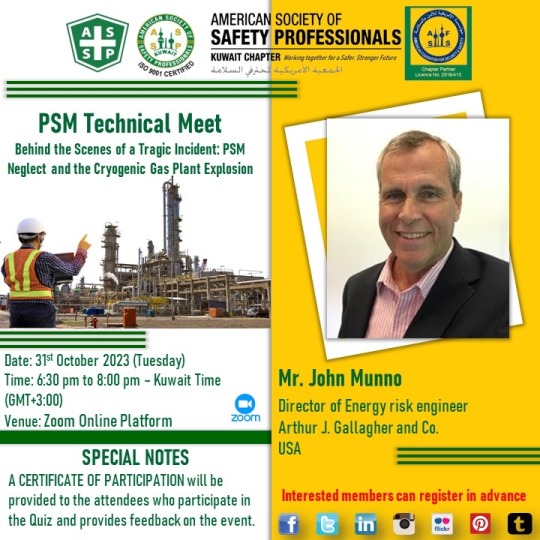#Process Safety Management
Explore tagged Tumblr posts
Text

NEBOSH PSM Special Offers in Kochi
Advance your career with NEBOSH PSM (Process Safety Management)!
Enroll now to boost your workplace safety expertise and gain access to 4 International HSE courses at a special discounted price.
Learn from a trusted Gold Learning Partner with a proven track record of a 100% pass rate in the recent batch.
Our virtual live & online training offers flexibility and convenience.
Mark your calendar for the upcoming batch: February 10th to February 20th, 2025. Don’t miss out—secure your spot today!
Contact: Mrs. Alphonsa
+918089011467
Visit us: https://greenwgroup.co.in/training-courses/nebosh/nebosh-psm-certificate/
#safetycourses#neboshtraining#nebosh#neboshonline#safetytraining#neboshexam#neboshpsm#process safety management
0 notes
Text
#OfQual#RQF#Qualifi#ESC#European Safety Council#IGC#ESC IGC#International Diploma#Safety Engineering#OHSM#PSM#IDHSE#Qualifi Level 7#Level 7 Diploma#Level 7 International Diploma#Level 7 Certificate#RQF Level 7#Grad IOSH#CMIOSH#IOSH#NVQ#Qualifi Level 7 International diploma in OHSM#Qualifi Level 7 International diploma in PSM#ESC’s IDHSE#MSC Uk#Process safety management#International diploma in Health and Safety Engineering#TSP#CSP#ASP
0 notes
Text
Discover Tata Steel Consulting's expertise in cultivating a culture of safety. Learn our premium program about our strategies and practices that prioritize workplace safety and enhance operational excellence.
#Culture of Safety Consulting#Tata Steel Industrial Consulting#TSIC#Safety Leadership Development#Process Safety Management#Contractor Safety Management
0 notes
Text
*Bhagyavati Placement & Services*
Hiring Urgent Requirement for Reputed Pharmaceutical at Visakhapatnam
Department: *Process Safety*
Designation: *Manager*
Location: *Visakhapatnam*
Qualification: *B. Tech (Chemical Engg)*
Experience: *12-16 Years in API Bulk Drug Pharma*
package: *Best in Industry*
Interview: *Telephonic*
Interview Date:*08.11.2023*
Interested Male candidates send their resume to *[email protected]* or contact *7799691139,8125394001*
#safety#process safety management#process safety gap assessment#process safety training#processsafety#eh science#black entrepreneurship#middle east#naturecore#israel#gaza#the amazing digital circus#climate change#reproductive rights#lgbtqia+#marketing
0 notes
Text

ASSP KC is thrilled to introduce the ASSP-KC PSM Specialty Group, an initiative committed to advancing Process Safety skills, promoting heightened awareness, and offering valuable networking opportunities.
In collaboration with the 2023-2024 Core Committee, our newly formed PSM Specialty Group has set in motion a vibrant PSM committee. Their primary goal is to enhance expertise in Process Safety by crafting informative articles, orchestrating training sessions, and facilitating monthly Process Safety Technical Meets.
Interested members can register in Advance.
for registration click the below link ���👇
http://send.assp.org/link.cfm?r=eRKIMYmPVVdiTLENcJJfjw~~&pe=2m-JV--cUfdmfP5qT6xpLWr0FLwLUGAhHFWr7GilbuoXvdWEbdYymrxglsz0eotfWIXZOC3lUpUmu6YnH8r2bw~~&t=frP6YtkxgN1bUu--J8-wyw~~
#asse kuwait#safety#assp kuwait chapter#assp kuwait#oilandgas#process safety management#like#comments#share#2023
1 note
·
View note
Text
Implementing New Elements into an Existing PSM System

Process Safety Management (PSM) systems are crucial in industries that handle hazardous materials and processes. These systems are designed to prevent accidents and protect both employees and the surrounding environment. However, as technology advances and industries evolve, it becomes necessary to enhance and adapt PSM systems to address emerging risks and challenges. In this article, we will discuss the steps and considerations involved in implementing new elements into an existing PSM system.
How Process Safety Management works?
Assessment of Current PSM System
Before introducing new elements into an existing PSM system, it's vital to conduct a comprehensive assessment of the current system. This involves reviewing existing policies, procedures, and practices, as well as evaluating their effectiveness. Identify areas where the current system may be lacking or where additional safety measures are required. This assessment serves as a baseline to determine what changes are needed.
Identify Emerging Risks
In today's rapidly changing industrial landscape, new risks and challenges constantly emerge. It's essential to stay informed about industry developments, technological advancements, and regulatory changes that may impact your operations. Conduct risk assessments to identify potential hazards associated with these changes. Common emerging risks include the use of new chemicals, modifications to existing processes, and the integration of automation and digital technologies.
Review Regulatory Requirements
Regulations governing process Safety Case often evolve to address new challenges and emerging risks. Review current regulations applicable to your industry and processes to ensure compliance. Identify any new requirements or guidelines that may necessitate changes to your PSM system. This step is crucial to avoid compliance gaps and potential legal consequences.
Engage Stakeholders
Implementing new elements into an existing PSM system should involve input from a range of stakeholders. This includes employees, safety experts, regulatory agencies, and even neighboring communities in some cases. Engaging stakeholders not only provides valuable insights but also fosters a sense of ownership and commitment to the enhanced safety measures. Communication and collaboration are key during this phase.
Develop a Plan for Integration
Once the new elements and enhancements are identified, develop a clear and detailed plan for integration. This plan should outline specific goals, timelines, resource requirements, and responsibilities. Consider how the new elements will be integrated into existing processes, procedures, and training programs. Ensure that all stakeholders understand the plan and their roles in its execution.
Employee Training and Awareness
Introducing new elements into a PSM system often requires training employees on the changes and their implications. Develop training programs that are tailored to the needs of different employee groups, from operators to management. Emphasize the importance of the new elements in enhancing safety and preventing incidents. Promote a culture of continuous learning and adaptation.
Implementation and Monitoring
Execute the plan for integrating new elements into the PSM system. Monitor the implementation process closely to ensure that it aligns with the established goals and timelines. Establish key performance indicators (KPIs) to measure the effectiveness of the new elements. Regularly assess and review progress, making adjustments as necessary.
Documentation and Reporting
Accurate and thorough documentation is a fundamental aspect of any PSM system. Ensure that all changes and enhancements are well-documented. This includes updated procedures, safety data sheets, risk assessments, and incident reporting protocols. Implement a reporting mechanism to capture and analyze data related to the new elements to identify trends and areas for improvement.
Auditing and Review
Regular audits and reviews are essential to verify the effectiveness of the new elements and the overall PSM system. Conduct internal and external audits to assess compliance with regulations and the organization's safety standards. Engage third-party experts if necessary to provide an objective evaluation. Use audit findings to make necessary adjustments and improvements.
Continuous Improvement
Enhancing a PSM system is an ongoing process. Encourage a culture of continuous improvement within the organization. Gather feedback from employees, stakeholders, and incident reports to identify areas that require further refinement. Stay proactive in identifying and addressing emerging risks, and be prepared to adapt the PSM system as needed.
Conclusion
Implementing new elements into an existing PSM system is a proactive approach to address emerging risks and ensure the ongoing safety of employees, the environment, and the surrounding communities. By conducting a thorough assessment, engaging stakeholders, and following a structured plan for integration, organizations can enhance their PSM systems effectively. The commitment to continuous improvement and compliance with evolving regulations will contribute to safer operations and a stronger safety culture in the long run.
For more: Process Safety Training, Operational Safety
0 notes
Text

"Unlocking the Benefits of NEBOSH HSE Certificate in Process Safety Management"
Introduction: Are You Prepared to Prevent Workplace Hazards?
What if the smallest mistake at work could lead to a dangerous accident, endangering lives and causing significant damage? In industries like oil, gas, chemicals, and manufacturing, even minor oversights can have serious consequences. That’s where the NEBOSH HSE Certificate in Process Safety Management (PSM) comes in. This globally recognized certification equips professionals with the skills to identify, manage, and reduce risks before they become major problems. By gaining NEBOSH PSM certification, you’ll not only improve safety standards but also play a key role in protecting your workplace from avoidable incidents.
READ MORE
#safetycourses#neboshtraining#nebosh#neboshonline#safetytraining#neboshpsm#process safety management#neboshhse#neboshexam
0 notes
Text
For those in the specialization of health and safety, improving dexterities and capabilities can open doors to rewarding functions in various industries, from edifice to oil and gas. The European Safety Council (ESC) offers a range of diplomas that focus on workplace safety and the management of occupational perils. Here’s a summary of some of the top diplomas presented by ESC, with key courses conceived to advance your expertise.
#OfQual#RQF#Qualifi#ESC#European Safety Council#IGC#ESC IGC#International Diploma#Safety Engineering#OHSM#PSM#IDHSE#Qualifi Level 7#Level 7 Diploma#Level 7 International Diploma#Level 7 Certificate#RQF Level 7#Grad IOSH#CMIOSH#IOSH#NVQ#Qualifi Level 7 International diploma in OHSM#Qualifi Level 7 International diploma in PSM#ESC’s IDHSE#MSC Uk#Process safety management#International diploma in Health and Safety Engineering#TSP#CSP#ASP
0 notes
Text
Safety Leadership Development Program | TSIC Elevate safety culture and performance with Tata Steel Consulting's Safety Leadership Development Program. Empower your leaders to champion safety excellence.
#TSIC#Safety Leadership Development#Tata Steel’s Safety Management System#Process Safety Management#Tata Steel Industrial Consultancy
0 notes
Link
SynergenOG , the engineering consultancy company headquartered in Kuala Lumpur having experienced engineering consultants specialized in Energy Industry. We help in creating a client-centric organization dedicated to bringing about a step change in process safety and create greater awareness in the energy industry
#Engineering Consultants#Technical Risk Management#Risk Assessment#Fire And Explosion Analysis#Safety Case#Operational Safety#Hazop Workshop#Process Safety Management#Process Safety Training
0 notes